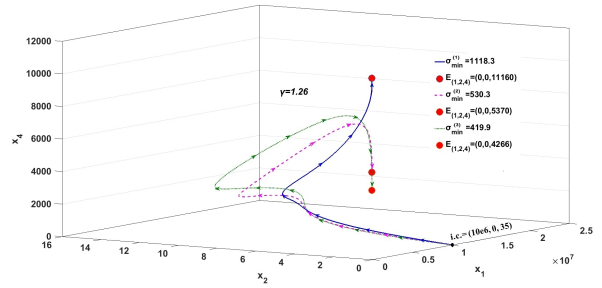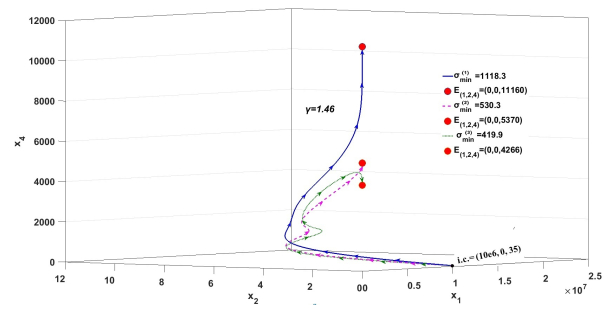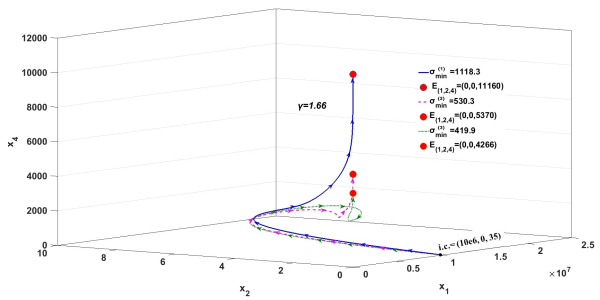In the present paper convergence dynamics of one tumor-immune-virus model is examined with help of the localization method of compact invariant sets and the LaSalle theorem. This model was elaborated by Eftimie et al. in 2016. It is shown that this model possesses the Lagrange stability property of positive half-trajectories and ultimate upper bounds for compact invariant sets are obtained. Conditions of convergence dynamics are found. It is explored the case when any trajectory is attracted to one of tumor-only equilibrium points or tumor-free equilibrium points. Further, it is studied ultimate dynamics of one modification of Eftimie et al. model in which the immune cells injection is included. This modified system possesses the global tumor cells eradication property if the influx rate of immune cells exceeds some value which is estimated. Main results are expressed in terms simple algebraic inequalities imposed on model and treatment parameters.
1.
Introduction
Sausages are processed meat products; and frankfurters are of emulsion type sausages, which are cured and added with seasonings [1]. Sausages are added with several food additives, such as nitrites and nitrates, in order to control the growth and toxin production of Clostridium botulinum as well as the development of desired flavor and color [2,3]. Nitrite can also be utilized as an antioxidant in cured meat products [3,4,5]. However, these compounds can have adverse health effects and cause N-nitrosamine production [3,6]. Thus, it is crucial to control and limit the level of nitrites and nitrates used in the production of cured meat products.
The undesired effects of the additives used in the processed meat products as antioxidants, antimicrobials, and color enhancers can be prevented by replacing them with natural plant extracts. For instance, Viuda-Martos, Ruiz-Navajas, Fernández-López and Pérez-Álvarez [7] reported that bologna sausages exhibited lower lipid oxidation and residual nitrite and higher sensory acceptance when they were added with citrus fiber washing water and rosemary essential oil. Moreover, addition of cassia and holy basil essential oils in fresh chicken sausages was also recommended by Sharma, et al. [8]. In addition, Alirezalu, Hesari, Eskandari, Valizadeh and Sirousazar [9] observed that ethanolic extracts of several plants, such as stinging nettle, olive leaves, and green tea, were effective on increasing the shelf life of frankfurter sausages.
It has been stated that tarragon has good antioxidant and antimicrobial properties [10,11,12]. For instance, Sharafati-Chaleshtori, et al. [13] reported that tarragon essential oil addition decreased microbial growth and increased overall acceptability of beef burgers. It was also stated that tarragon essential oil was effective on shelf life extension of beef slices [11].
There have been no studies in literature evaluating the addition of tarragon essential oil to sausages. The aim of the study was to investigate the effects of tarragon essential oil on the sensory properties and color of the frankfurter type sausages.
2.
Materials and methods
2.1. Material
Fresh tarragon (Artemisia dracunculus) leaves were obtained from a local producer. All other ingredients were purchased from local market.
2.2. Isolation of essential oil
A 100 g of fresh tarragon leaves were added with 1500 mL distilled water and hydrodistillated for 3 h using a Clevenger-type apparatus. The amount of essential oil obtained was measured using the volumetric scale of the apparatus. The essential oil yield from the fresh tarragon leaves was calculated as 0.3% (v/w). The essential oil (EO) was stored in amber vials at −18 ℃.
2.3. Preparation of the samples
The control samples were prepared using the following ingredients per kg: 620 g beef meat, 175 g ice-water, 94 g starch, 75 g sunflower oil, 12 g salt, 12 g white pepper, 6 g granulated garlic, and 6 g ground cumin. Samples with tarragon essential oil (0.1% EO, v/w) were prepared by adding a 100 μL of the essential oil to a 100 g of the prepared sausage batter. The samples without the essential oil were used as the control (0% EO, v/w).
The prepared sausage batter was stuffed into 21 mm-diameter synthetic casings manually. The internal temperature of the samples was maintained below 4 ℃ during preparation. The sausages heated in a steam oven to 74 ℃ internal temperature. The heat-treated sausages were then cooled to 4 ℃ in a blast chiller (RBC201, Electrolux, Sweden). In addition, one random sample of the heat treated frankfurters and the sausage batters (samples before the heat treatment) from each level of essential oil addition and replication were separated in order to be used for color measurement.
2.4. Sensory analysis
A hedonic test and a triangle test were used in the assessment of the sensory properties of the samples. Sausages were cut into approximately 6 g pieces (20 mm × 21 mm) and cooked in a microwave oven (Menumaster RCS511TS, ACP Inc., USA) for 60 s before serving the panelists.
The hedonic test was conducted with 12 panelists. Odor, color intensity, flavor, spiciness, hardness, and overall acceptability properties of the samples were assessed using a 7-point hedonic scale (1: very weak or very unacceptable, 7: very strong or very acceptable).
The triangle test was conducted with 30 panelists. The panelists were given with 3 samples (2 of them were the same and 1 was different), and asked to find the odd sample and whether they prefer any of the samples.
2.5. Color measurement
The CIELAB L* (lightness, 0–100), a* (negative: greenness, positive: redness) and b* (negative: blueness, positive: yellowness) values were measured using a color meter (CR-400, Konica Minolta Sensing, Inc., Japan). The device was calibrated using a white plate before the measurement. Three different measurements were taken, and the averages were recorded. Chroma (C*) values were also calculated according to Eq 1.
2.6. Statistical analysis
All treatments were replicated twice in the study. Statistical analysis of data was performed using Minitab 17 statistical software. The hedonic test data were assessed using a completely randomized block design. The data obtained by the triangle test was assessed according to Roessler, Pangborn, Sidel and Stone [14].
3.
Results and discussion
Tarragon essential oil was added to the sausages at a concentration of 0.1% (v/w), and similar amounts of tarragon essential oil was reported to exhibit antimicrobial activity in meat products previously [11,13]. It was also reported that tarragon essential oil may contain 75% estragole (methyl chavicol) [15,16,17]. However, the consumption of estragole should be limited, as it was reported to have carcinogenic and genotoxic properties [15,16]. Thus, higher concentrations of tarragon were not assessed in this study.
The effects of tarragon essential oil on the sensory properties of the frankfurters are demonstrated in Table 1. The sensory odor, color intensity, and hardness of the tarragon essential oil added frankfurters were not significantly different than those of the control (P > 0.05). The spiciness of the frankfurters added with the tarragon essential oil was stronger than the control (P < 0.05). The flavor of the control was more acceptable compared to the samples with the essential oil (P < 0.05). Thus, it could be said that the difference in the flavor of the samples is due to the difference in spiciness rather than odor. In addition, the overall acceptability of the control was also higher compared to samples with the essential oil (P < 0.05). Similarly, da Silveira, et al. [18] reported that Tuscan sausages without essential oil had higher acceptability compared to 0.05% and 0.1% bay leaf essential oil added samples. The sensory scores of cooked pork sausages containing aqueous extract of mint were lower compared to control samples without the extract in a study by Latoch and Stasiak [19]. According to Kos, et al. [20] addition of 0.005% and 0.01% bay leaf essential oil decreased the consumers' willingness to buy and acceptability of dry game sausages.
The flavor and overall acceptability of the frankfurters can be increased by decreasing the amount of the essential oil. Garcia-Diez, et al. [21] reported that the consumer acceptance of dry cured sausages (churiço) was significantly decreased with 0.05% addition of essential oils from several herbs and spices, such as bay, garlic, nutmeg, oregano, rosemary, and thyme to the formulation; however, it was higher when the concentration of the essential oils were reduced to 0.005%. Moreover, Sharafati-Chaleshtori, et al. [13] reported that addition of tarragon essential oil at 0.125% concentration increased overall acceptability of beef burgers compared to the samples with 0%, 0.25% and 0.062% essential oil.
The difference between the control and the samples with the essential oil was significant according to the triangle test (P < 0.05). A 27% of the panelists participated in the triangle test preferred the essential oil containing sausages, whereas a 63% of the panelists preferred the control.
The essential oil addition did not significantly affect the L*, a*, b*, or C* values of the frankfurters (heat treated) (Figure 1) or the sausage batter samples that were not heat treated (Figure 2). Similarly, it has been stated that the addition of oregano essential oil did not affect the L*, a*, b* values of fermented sausages [22]. Sojic, et al. [23] reported that nutmeg essential oil addition did not change the color of cooked sausages similar to our results. However, frankfurters added with rosemary essential oil had different L* and b* values compared to the samples without the essential oil [24]. On the other hand, the a*, b*, and C* values were decreased after the heat treatment (P < 0.05).
4.
Conclusion
The 0.1% (v/w) addition of tarragon essential oil decreased the flavor and overall acceptability of the frankfurter type sausages. The spiciness of the frankfurters with the essential oil was higher compared to the control. However, the effects of the treatment on the other sensory properties and the color were not significant. In conclusion, it can be said that the undesired effect of the tarragon essential oil on the flavor and the overall acceptability could be eliminated by modifying the amount of the essential oil added. The amount of the tarragon essential oil that could be used in frankfurter type sausage formulation should be optimized by further studies also evaluating the antioxidant and antimicrobial properties.
Acknowledgments
We would like to thank Prof. Dr. Gurbuz Gunes of Istanbul Technical University for letting us use the laboratory facilities and reading the manuscript. Yildiz Gıda Yapi A.S. (Istanbul, Turkey) is also acknowledged for providing the sausage casings.
Conflict of interest
The authors declare no conflict of interests in this research.









 DownLoad:
DownLoad:







